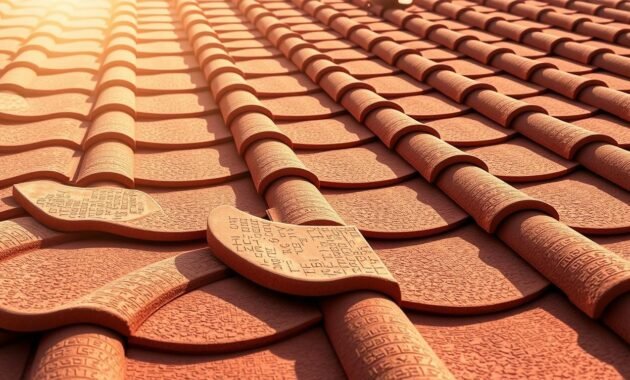Choosing the right roofing material is a big decision for homeowners. Clay roofing might seem pricey and complicated. This can lead to frustration over the cost of replacing a roof.
Traditional roofing materials don’t last long. They cause maintenance problems and add to your expenses.
But, clay tile roofs can last up to 75 years or more. They are incredibly durable. Knowing about clay roofing can help homeowners make a wise choice. It protects their homes and saves money on upkeep.
My research shows that clay tile roofing is a top choice for homeowners. It offers reliable and long-lasting roof protection.

Read also: Pros and Cons of Synthetic Slate Roofing
Understanding Clay Tile Roofing Systems
Clay tile roofing systems are a mix of old-world craftsmanship and new technology. They’ve been protecting homes for thousands of years. They offer both durability and beauty, making them a favorite among homeowners.
Historical Significance of Clay Tiles
Clay tiles have a long history, dating back to ancient times. They were first used in places like Mesopotamia and the Mediterranean. These tiles have been key in building designs for over 10,000 years.
- Earliest known use dates back to 10,000 BCE
- Prominent in Mediterranean and Middle Eastern architecture
- Spread globally through trade and colonization
Components of Clay Tile Roofs
Modern clay tile roofs have several important parts. These parts work together to protect against the weather. They help the roof last a long time.
| Component | Function | Material |
|---|---|---|
| Clay Tiles | Primary protective layer | Terracotta, ceramic |
| Underlayment | Water barrier | Synthetic materials |
| Flashing | Seal possible leak points | Metal (copper, aluminum) |
Manufacturing Process and Materials
Making clay tiles is a detailed process. It starts with finding and preparing the clay. Then, it’s fired at high temperatures to make it strong.
- Raw clay extraction
- Material preparation and mixing
- Molding and shaping
- High-temperature firing
- Quality control and finishing
The materials used in clay tile roofs affect their performance. Natural terracotta is often chosen for its beauty and strength.
Clay Tile Roof Lifespan: What You Need to Know
When you think about roofing, knowing how long a clay tile roof lasts is key. These roofs are known for being very durable and lasting a long time. With proper care, a clay tile roof can last 50 to 100 years. Some even last up to 150 years.
Read also: How Long do Tile Roofs Last

- Exceptional material quality that resists weather damage
- Ability to withstand extreme temperature variations
- Natural resistance to rot, insects, and fire
- Minimal maintenance requirements
I’ve seen clay tile roofs on old buildings that are decades old. The secret to their long life is professional installation and regular checks. Things like the weather, how it’s installed, and upkeep affect how long it lasts.
Homeowners should know that performance varies. In places with mild weather, clay tile roofs often last more than 50 years. In areas like the Mediterranean and Southwest, some roofs have lasted over a century.
Choosing a clay tile roof is a smart long-term investment. It might cost more upfront than other materials. But, its long life and low need for replacement make it a wise choice for homeowners.
Comparing Clay Tiles to Other Roofing Materials
Homeowners have many choices when picking a roof. I’ll compare clay tiles to other popular options. We’ll look at how they last and perform.
Roofing materials differ in lifespan, cost, and strength. Let’s see how clay tiles stack up against other choices.
Read also: Best Time of Year to Remove Moss from Roof
Asphalt Roof Shingle Performance
Asphalt shingles are the top choice in the U.S. They last 20-30 years, which is good for your wallet. But, clay tiles beat them in:
- Cost less upfront
- Require more frequent replacement
- Offer less aesthetic variety
Metal Roofing Characteristics
Metal roofs are known for their long life. They can last 40-60 years, rivaling clay tiles. They also have:
- Excellent weather resistance
- Lightweight design
- Energy-efficient reflective properties
Concrete Tile Alternative
Concrete tiles are another durable option. They’re similar to clay tiles in:
- Approximately 50-year lifespan
- Strong structural integrity
- Superior fire resistance
Clay tiles are known for their long life and beauty. They outshine many other roofing materials.
Factors Affecting Clay Tile Roof Durability

Protecting your home starts with knowing what affects tile roof durability. Clay tile roofs are known for lasting long. But, several important factors can change how well they perform and last.
The quality of the roof replacement and the initial installation is key. A professional job ensures tiles are aligned right, securely attached, and the underlayment is ready. This helps avoid problems later on.
- Proper installation techniques
- Quality of initial roofing materials
- Professional expertise during installation
- Precise underlayment preparation
Weather conditions also play a big role in how well clay tile roofs do. Places with big temperature changes, lots of storms, or high humidity can make roofs wear out faster. Homeowners should think about their local weather when getting a tile roof.
Keeping up with regular maintenance is also vital. Checking your roof often can spot problems early, saving you money. Important maintenance steps include:
- Clearing debris from roof surfaces
- Checking for cracked or damaged tiles
- Inspecting flashing and underlayment
- Addressing minor repairs promptly
The strength of your home’s foundation and roof frame also matters. They need to support the roof well to avoid damage to the tiles.
Weather Resistance and Climate Considerations
Clay tile roofs are known for their durability, making them a top choice for homeowners. They perform well in many weather conditions. My experience with roofing materials shows clay tiles are exceptional.
Clay tiles are great for areas with extreme weather. They offer strong protection against harsh conditions. This makes them a top pick for many.
Heat and UV Protection
In hot climates, clay tiles are a standout. They reflect sunlight, keeping homes cooler and saving on energy. The benefits include:
- Natural thermal insulation properties
- Reduced heat absorption
- Extended roof lifespan in intense sunlight
Performance in Extreme Conditions
Clay tile roofs are very resilient in severe weather. They can handle strong winds, heavy rain, and hail well.
| Weather Condition | Clay Tile Performance |
|---|---|
| High Winds | Excellent Resistance |
| Heavy Rain | Superior Water Shedding |
| Hailstorms | Strong Impact Protection |
Regional Climate Impact
Clay tiles work well in different climates. They handle the heat of the desert and the humidity of the coast.
- Southwest: Ideal for extreme heat resistance
- Southeast: Excellent moisture management
- Coastal Areas: Saltwater and wind-resistant
Choosing a clay tile roof is a smart move. It’s a durable choice that keeps your home safe from harsh weather.
Essential Maintenance for Clay Tile Roofs
Keeping your clay tile roof in good shape is key to making it last longer. Regular maintenance helps keep your roof in top condition for years. This way, you avoid the need for early roof replacement.
I suggest a detailed maintenance plan that covers several important steps. Start with regular checks and taking care of your roof system.
- Conduct annual professional roof inspections
- Clean tiles and remove debris twice a year
- Check for cracked or damaged tiles immediately
- Maintain proper attic ventilation
- Replace underlayment every 20-30 years
Read also: How Much Is a Roof Inspection?
It’s important to check each tile for damage. Broken tiles can let water in and cause costly damage. I recommend fixing any broken tiles right away.
Roof experts can spot problems during inspections. They’ll check your roof’s condition and suggest ways to keep it safe. This helps protect your home’s structure.
Preventive care is cheaper than fixing big problems. Regular maintenance extends your roof’s life and keeps your property’s value high.
Investment Value and Long-term Benefits
Choosing a clay tile roof is more than just a choice for looks. It’s a smart investment that saves money in the long run. These roofs are known for their great performance and long life.
When you think about upgrading your roof, knowing the financial benefits of clay tile roofs is key. Let’s look at why this option is a wise choice.
Energy Efficiency Advantages
Clay tile roofs are great at saving energy. They keep your home cool by blocking heat. This can lower your cooling bills a lot in summer.
- Reflects solar radiation
- Reduces indoor temperature by up to 15%
- Minimizes air conditioning expenses
Property Value Impact
Getting a clay tile roof can really boost your home’s value. These roofs are known for being strong and looking good. This means your home will be worth more.
| Roofing Type | Property Value Increase | Lifespan |
|---|---|---|
| Clay Tile Roof | 5-8% | 50-100 years |
| Asphalt Shingles | 2-3% | 15-30 years |
Cost Analysis Over Time
Clay tile roofs might cost more to install at first. But they last so long, they save you money over time. They need little upkeep, making them a smart choice for homeowners.
- Lower lifetime replacement costs
- Reduced maintenance expenses
- Enhanced home protection
Professional Installation Requirements
Professional installation is key for clay roofing. It’s not just a suggestion; it’s a must. Clay tile roofing systems need special skills that go beyond regular roofing. Experts are needed to handle the complex details of placing clay tiles and supporting the structure.
Finding the right roofing contractor is vital for your clay roofing’s success. Here are some important points to consider:
- Make sure the contractor has experience with clay tile roofing.
- Check if they have the right certifications and credentials.
- Ask to see their portfolio of clay tile projects.
- Ensure they know the local building codes.
Proper installation involves many important steps. These steps affect how well the roofing system works. Professionals need to:
- Check if the structure can hold the weight.
- Prepare the underlayment correctly.
- Align and space the tiles accurately.
- Use the right fastening methods.
| Installation Aspect | Professional Requirements |
|---|---|
| Structural Assessment | Comprehensive home foundation evaluation |
| Material Selection | Climate-specific tile and underlayment choices |
| Technical Expertise | Advanced roofing system knowledge |
Choosing professional installation protects your investment. It ensures your clay roofing system works at its best. The right skills turn clay tiles into a beautiful architectural feature.
Conclusion
Exploring clay tile roof lifespan shows they’re more than just pretty. A well-installed clay tile roof can last 50 to 100 years with care. They’re durable, look great, and are a smart long-term investment.
Choosing a tile roof means considering a few key things. Climate, how well it’s installed, and regular upkeep are all important. Getting it done right by pros and keeping up with maintenance can make it last longer.
While clay tiles cost more upfront, they save money in the long run. They’re energy-efficient, need little replacement, and boost your home’s value. Investing in a quality clay tile roof means protecting your home for years to come.
I suggest hiring local roofers who know clay tiles and your area’s weather. This way, your roof will work well and keep your home safe for many years.




